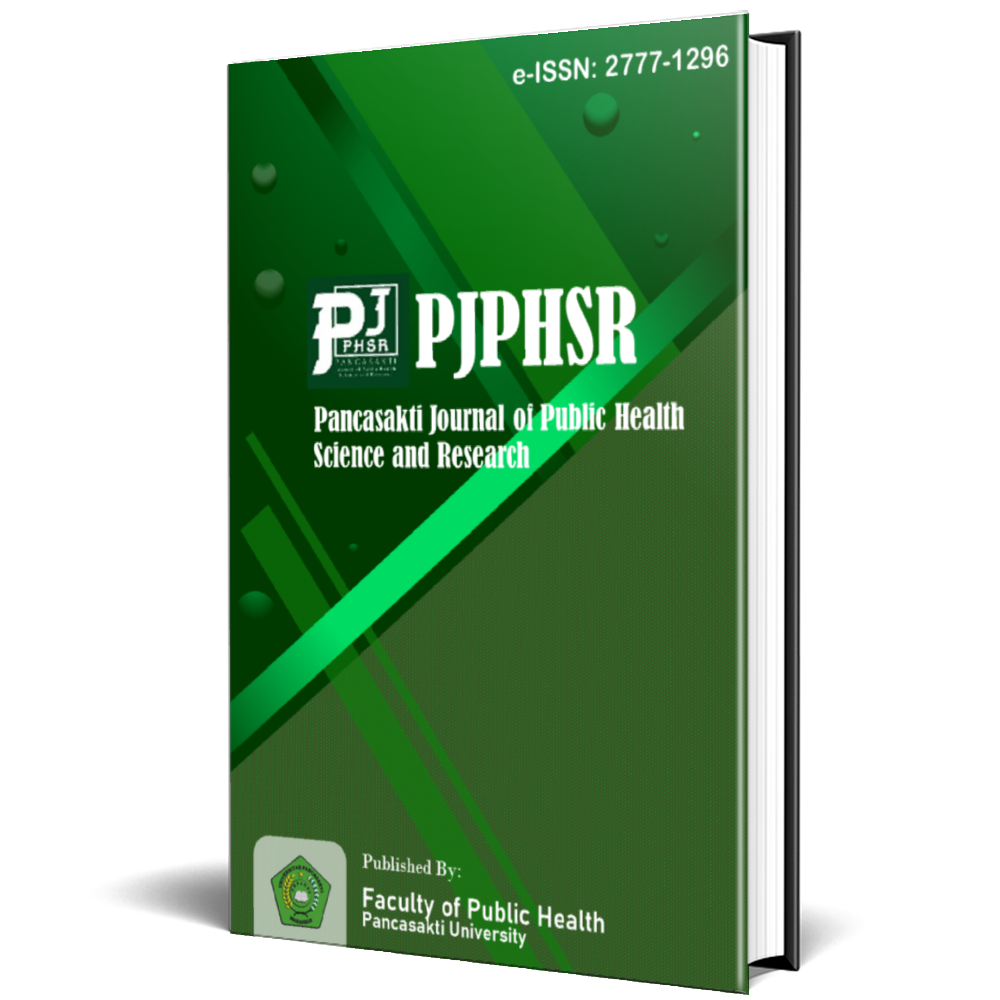Development and Usability Evaluation of an IT-Based Disaster Medical Record System in South Kalimantan, Indonesia
Abstract
Indonesia, as a disaster-prone region, requires a resilient health information system. Conventional paper-based medical records are vulnerable to damage and inefficient in emergency response, making the development of an electronic disaster medical record crucial. This study aims to design and test the usability of a web-based electronic disaster medical record prototype. This study used a prototyping method involving 32 medical records staff from hospitals in South Kalimantan. System usability evaluation was conducted using the System Usability Scale (SUS) questionnaire through usability testing with a disaster documentation task scenario. Statistical analysis was performed by calculating the SUS score using a standard formula that yields a score of 0-100. The results showed an average SUS score of 79.31, which is classified as grade B (good) on the acceptability scale, indicating that the system is acceptable and meets basic usability aspects well. This finding proves that the electronic disaster medical record prototype is feasible and has the potential to improve victim data management, although there is still room for refinement of certain elements to achieve an excellence level. The implementation of this system is expected to be integrated with the national health platform to support more effective disaster response.
References
Apriliyani, N.K.M.K., Feoh, G. and Kartiko, B.H. (2020) ‘Medical Record Digitalization Design of Natural Disasters Patients At Disaster-Prone Hospital’, Proceeding of International Conference on fundamental and Applied Research, (October), pp. 199–205. Available at: https://jurnal.undhirabali.ac.id/index.php/icfar/article/view/970%0Ahttps://jurnal.undhirabali.ac.id/index.php/icfar/article/download/970/871.
Arena, F. and Bora, L. (2022) ‘Predictive Analytics For National Emergency Preparedness’, (January). Available at: https://www.researchgate.net/publication/387829264.
Asih, H.A. et al. (2024) ‘Rancangan Formulir Rekam Medis Bencana’, Jurnal Promotif Preventif, 7(6), pp. 1139–1145.
Badan Nasional Penanggulangan Bencana (2023) RISIKO BENCANA INDONESIA ‘Memahami Risiko Sistemik di Indonesia’, Bnpb. Available at: https://inarisk.bnpb.go.id/BUKU-RBI-2022/mobile/index.html#p=10.
Baek, J. et al. (2021) ‘Assessing patient needs during natural disasters: Mixed methods analysis of portal messages sent during hurricane harvey’, Journal of Medical Internet Research, 23(9), pp. 1–16. Available at: https://doi.org/10.2196/31264.
Bangor, A., Kortum, P.T. and Miller, J.T. (2008) ‘An Empirical Evaluation of the System Usability Scale’, International Journal of Human–Computer Interaction, 24(6), pp. 574–594. Available at: https://doi.org/10.1080/10447310802205776.
Beaudouin-lafon, M., Paris-sud, U. and Mackay, W.E. (2020) ‘Prototyping Tools and Techniques’, The Human-Computer Interaction Handbook, pp. 1043–1066. Available at: https://doi.org/10.1201/9781410615862-66.
Buford, A. et al. (2022) ‘Systematic review of electronic health records to manage chronic conditions among displaced populations.’, BMJ open, 12(9), p. e056987. Available at: https://doi.org/10.1136/bmjopen-2021-056987.
Castulik, P. (2017) ‘Patient Isolation Units, Performance-Avoidance: A Patient with Heat Stress Risk during Temporary Isolation and Transportation by the EMS Biohazard Team’, Prehospital and Disaster Medicine, 32(S1), pp. S95–S96. Available at: https://doi.org/10.1017/s1049023x17002461.
Chan, T.C. et al. (2011) ‘Impact of wireless electronic medical record system on the quality of patient documentation by emergency field responders during a disaster mass-casualty exercise’, Prehospital and Disaster Medicine, 26(4), pp. 268–275. Available at: https://doi.org/10.1017/S1049023X11006480.
Checchi, F. et al. (2017) ‘Public health information in crisis-affected populations: a review of methods and their use for advocacy and action.’, Lancet (London, England), 390(10109), pp. 2297–2313. Available at: https://doi.org/10.1016/S0140-6736(17)30702-X.
Christian, K.R. et al. (2015) ‘Di Rumah Sakit Mardi Rahayu Kudus’, Jurnal Kesehatan Masyarakat, 3(April), pp. 465–474.
Demers, G. et al. (2013) ‘Secure scalable disaster electronic medical record and tracking system.’, Prehospital and disaster medicine, 28(5), pp. 498–501. Available at: https://doi.org/10.1017/S1049023X13008686.
Demir Özbek, E., Yomralıoğlu, T. and Ateş Aydar, S. (2023) ‘Development of Interoperability Principles for Disaster and Emergency Management System of Türkiye’, International Journal of Environment and Geoinformatics, 10(4), pp. 90–104. Available at: https://doi.org/10.30897/ijegeo.1396579.
Draugelis, S.D. et al. (2025a) ‘Development and implementation of an electronic health record system for use in humanitarian emergencies, disaster response, and conflict zones’, PLOS Global Public Health, 5(1), p. 2024. Available at: https://doi.org/10.1371/journal.pgph.0003124.
Draugelis, S.D. et al. (2025b) ‘Development and implementation of an electronic health record system for use in humanitarian emergencies, disaster response, and conflict zones’, PLOS Global Public Health, 5(1), pp. 1–11. Available at: https://doi.org/10.1371/journal.pgph.0003124.
Edmund, L.C.S., Ramaiah, C.K. and Gulla, S.P. (2009) ‘Electronic Medical Records Management Systems: An Overview’, DESIDOC Journal of Library & Information Technology, 29(6), pp. 3–12. Available at: https://doi.org/10.14429/djlit.29.273.
Faisal, H.P. and Nakayama, M. (2024) ‘Implementation of the World Health Organization Minimum Dataset for Emergency Medical Teams to Create Disaster Profiles for the Indonesian SATUSEHAT Platform Using Fast Healthcare Interoperability Resources: Development and Validation Study.’, JMIR medical informatics, 12, p. e59651. Available at: https://doi.org/10.2196/59651.
Gaebel, J., Schreiber, E. and Neumuth, T. (2024) ‘The Emergency Medical Team Operating System — a vision for field hospital data management in following the concepts of predictive, preventive, and personalized medicine’, EPMA Journal, 15(2), pp. 405–413. Available at: https://doi.org/10.1007/s13167-024-00361-9.
Ghosh, A., Yan, Y. and Lin, W. (2025) ‘2023-Adaptive User Interface Framework Powered by a Large Language Model for Culturally Sensitive Virtual Healthcare Applications Adaptive User Interface Framework Powered by a Large Language Model for Culturally Sensitive Virtual Healthcare Applications *’, (May).
Horahan, K. et al. (2014) ‘Electronic Health Records Access During a Disaster’, Online Journal of Public Health Informatics, 5(3), pp. 1–6. Available at: https://doi.org/10.5210/ojphi.v5i3.4826.
Kementerian Kesehatan Republik Indonesia (2010) ‘Pusat Penanggulangan Krisis Kesehatan Pedoman Teknis’, Kementerian Kesehatan Republik Indonesia [Preprint].
Kementrian Kesehatan Republik Indonesia (2019) Peraturan Menteri Kesehatan Republik Indonesia Nomor 47 Tahun 2019, Kementerian Kesehatan Republik Indonesia. Available at: http://www.ncbi.nlm.nih.gov/pubmed/7556065%0Ahttp://www.pubmedcentral.nih.gov/articlerender.fcgi?artid=PMC394507%0Ahttp://dx.doi.org/10.1016/j.humpath.2017.05.005%0Ahttps://doi.org/10.1007/s00401-018-1825-z%0Ahttp://www.ncbi.nlm.nih.gov/pubmed/27157931.
Lestari, F. et al. (2022) ‘Analysis of Hospital’s Emergency and Disaster Preparedness Using Hospital Safety Index in Indonesia’, Sustainability (Switzerland), 14(10). Available at: https://doi.org/10.3390/su14105879.
Mamlin, B.W. et al. (2021) ‘OpenMRS as an emergency EMR—How we used a global good to create an emergency EMR in a week’, International Journal of Medical Informatics, 149(February), p. 104433. Available at: https://doi.org/10.1016/j.ijmedinf.2021.104433.
Meidani, Z. et al. (2023) ‘Usability Assessment of an Electronic Medical Record-Embedded Clinical Decision Support System for Arterial Blood Gas Interpretation.’, Studies in health technology and informatics, 305, pp. 456–459. Available at: https://doi.org/10.3233/SHTI230530.
Oikawa, K., Murakami, M. and Ochi, S. (2024) ‘Use of personal health records during and after a disaster including a nuclear accident: A scoping review’, International Journal of Disaster Risk Reduction, 111, p. 104698. Available at: https://doi.org/https://doi.org/10.1016/j.ijdrr.2024.104698.
Perakslis, E.D. (2018) ‘Using digital health to enable ethical health research in conflict and other humanitarian settings Chesmal Siriwardhana and Donal O’mathuna’, Conflict and Health, 12(1), pp. 1–8. Available at: https://doi.org/10.1186/s13031-018-0163-z.
Perrig, S.A.C. et al. (2024) Development and Psychometric Validation of a Positively Worded German Version of the System Usability Scale (SUS), International Journal of Human-Computer Interaction. Available at: https://doi.org/10.1080/10447318.2024.2434720.
Ratwani, R. (2017) ‘Electronic Health Records and Improved Patient Care: Opportunities for Applied Psychology.’, Current directions in psychological science, 26(4), pp. 359–365. Available at: https://doi.org/10.1177/0963721417700691.
Schnall, A.H. et al. (2011) ‘Evaluation of a Standardized Morbidity Surveillance Form for Use during Disasters Caused by Natural Hazards’, Prehospital and Disaster Medicine. 2011/05/05, 26(2), pp. 90–98. Available at: https://doi.org/DOI: 10.1017/S1049023X11000112.
Seha, H.N., Santoso, J. and Susanti, H. (2018) ‘Kesiapsiagaan Penangulangan Bencana Berdasarkan Hospital Disaster Plan Di Rumah Sakit Pku Muhammadiyah Yogyakarta’, Jurnal Permata Indonesia, 9(1). Available at: https://doi.org/10.16383/j.aas.2018.cxxxxxx.
Shinchi, K. and Ashida, H. (2003) ‘Proposal of a model for medical records for international disaster relief operations.’, Military medicine, 168(2), pp. 120–123.
Shrestha, A. et al. (2022) ‘Innovation is needed in creating electronic health records for humanitarian crises and displaced populations’, Frontiers in Digital Health, 4(September), pp. 1–4. Available at: https://doi.org/10.3389/fdgth.2022.939168.
Copyright (c) 2025 Hastin Atas Asih, Indrayadi Indrayadi, Muhamad Heriyadi, Nur Sa'adah Hayati, Rahardina Dwi Chantika

This work is licensed under a Creative Commons Attribution-NonCommercial-ShareAlike 4.0 International License.








